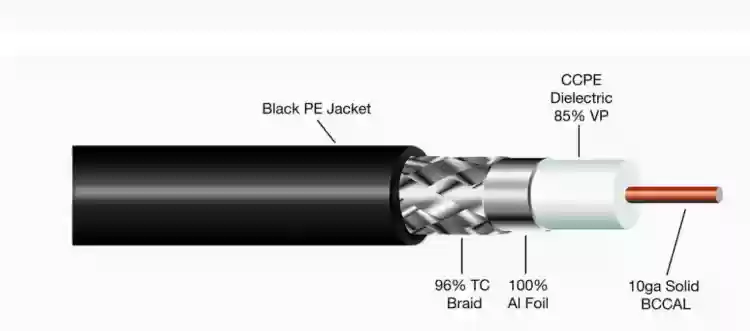HLF cables are essential in industries requiring low signal loss, particularly in RF (radio frequency) applications. These cables are designed for high-frequency transmission, making them ideal for telecommunications, broadcasting, and wireless networks. Among the different variants, the HLF 400 cable stands out for its superior performance. In this article, we’ll explore the structure, applications, and importance of choosing the right HLF cable manufacturer to ensure quality.
What is an HLF Cable?
An hlf cable is a type of coaxial cable designed to minimize signal loss during gfrequency transmission. Coaxial cables consist of an inner conductor, a dielectric insulator, an outer conductor (shield), and an outer jacket. The term “HLF” refers to High-Loss Factor, meaning these cables are engineered to reduce attenuation or signal degradation, allowing the transmission of RF signals over long distances with minimal interference.
HLF 400 Cable Structure
The HLF 400 cable is a popular option for applications that demand low signal loss and durability. The construction of this cable makes it suitable for both indoor and outdoor installations:
- Inner Conductor: Typically made of solid copper or copper-clad aluminum, the inner conductor is responsible for carrying the RF signal. Copper is preferred for its excellent conductivity, ensuring efficient signal transmission.
- Dielectric Insulator: Surrounding the inner conductor is a dielectric insulator, usually made from polyethylene foam. This insulator maintains signal integrity by preventing interference between the inner conductor and the outer shield.
- Outer Conductor (Shield): The outer conductor, usually a combination of aluminum foil and braided copper, acts as a shield against electromagnetic interference (EMI). This double-shielding design provides effective protection, keeping external signals from affecting the transmitted signal.
- Outer Jacket: The cable’s outer jacket, often made from PVC or polyethylene, provides physical protection. It is designed to withstand environmental factors like moisture, UV rays, and extreme temperatures, making the HLF 400 cable suitable for outdoor use in harsh conditions.
Applications of HLF Cable
HLF cables have broad applications due to their low signal loss and reliability. Some of the key uses include:
1. Telecommunications
In telecommunications, hlf cables connect antennas to transmitters and receivers, ensuring efficient signal transmission. These cables are essential in cellular networks, where maintaining signal quality over long distances is critical. The HLF 400 cable is commonly used in 4G and 5G base stations, ensuring low-loss signal transmission for wireless communication.
2. Broadcasting
HLF cables are used in broadcasting systems to transmit audio and video signals between studios and broadcast towers. Given the need for high-quality signal transmission, these cables are preferred for their ability to minimize interference. The HLF 400 cable, in particular, ensures that signals remain clear, even in the presence of external interference.
3. Satellite Communication
In satellite communication systems, HLF cables are used to connect satellite dishes to receivers. These cables help maintain signal integrity, allowing for clear and uninterrupted communication between the satellite and ground stations. The HLF 400 cable is often chosen for its excellent performance in high-frequency applications.
4. Wi-Fi and Wireless Networks
Wireless networks, such as Wi-Fi, rely on HLF cables to connect antennas to routers or access points. These cables help ensure strong signal transmission with minimal loss, improving overall network performance. The HLF 400 cable is frequently used in outdoor wireless installations, where maintaining signal strength is essential.
5. Military and Aerospace
HLF cables are widely used in military and aerospace applications, where communication reliability is crucial. These cables are used in radar systems, communication equipment, and navigation systems, providing low-loss signal transmission even in challenging environments.
Benefits of Using HLF 400 Cable
The HLF 400 cable offers several advantages, making it a preferred choice in many industries:
- Low Signal Loss: The primary benefit of HLF 400 cable is its low signal loss. This feature is critical in applications where signal strength must be maintained over long distances.
- Wide Frequency Range: The HLF 400 cable supports a broad frequency range, making it suitable for a variety of applications, from VHF and UHF to microwave frequencies.
- Durability: Designed for outdoor and indoor use, the HLF 400 cable can withstand extreme environmental conditions, such as moisture, UV exposure, and temperature fluctuations. This durability makes it ideal for use in outdoor wireless installations, satellite communication, and military applications.
- High-Quality Shielding: The double-shielding design of the HLF 400 cable ensures minimal electromagnetic interference, which is essential for maintaining signal quality, especially in environments with high levels of external interference.
How to Choose the Right HLF Cable Manufacturer
Choosing a reliable HLF cable manufacturer is essential for ensuring that you get high-quality cables that meet your specific needs. Here are some factors to consider when selecting a manufacturer:
- Quality and Standards Compliance: Ensure that the manufacturer adheres to industry standards, such as ISO or RoHS. High-quality HLF cables should meet specific performance metrics, including low attenuation, impedance matching, and shielding effectiveness.
- Customization Options: Depending on your application, you may require custom cables in terms of length, connectors, or jacket material. A reputable HLF cable manufacturer should offer customization options to meet your requirements.
- Technical Support: A good manufacturer will provide technical support to help you select the right cable for your application. This support should include assistance with installation and troubleshooting.
- Pricing and Lead Time: While quality is essential, pricing and delivery time also matter. Compare prices from different HLF cable manufacturers and ensure they can deliver within your project timeline.
- Reputation and Reviews: Research the manufacturer’s reputation by checking customer reviews or testimonials. A manufacturer with positive feedback from previous customers is more likely to provide high-quality products.
Conclusion
HLF cables, particularly the HLF 400 cable, are vital in industries requiring low-loss, high-frequency signal transmission. Their applications range from telecommunications and broadcasting to satellite communication and wireless networks. When selecting an HLF cable manufacturer, consider factors like quality standards, customization options, and technical support to ensure that you get the best possible product for your needs.












